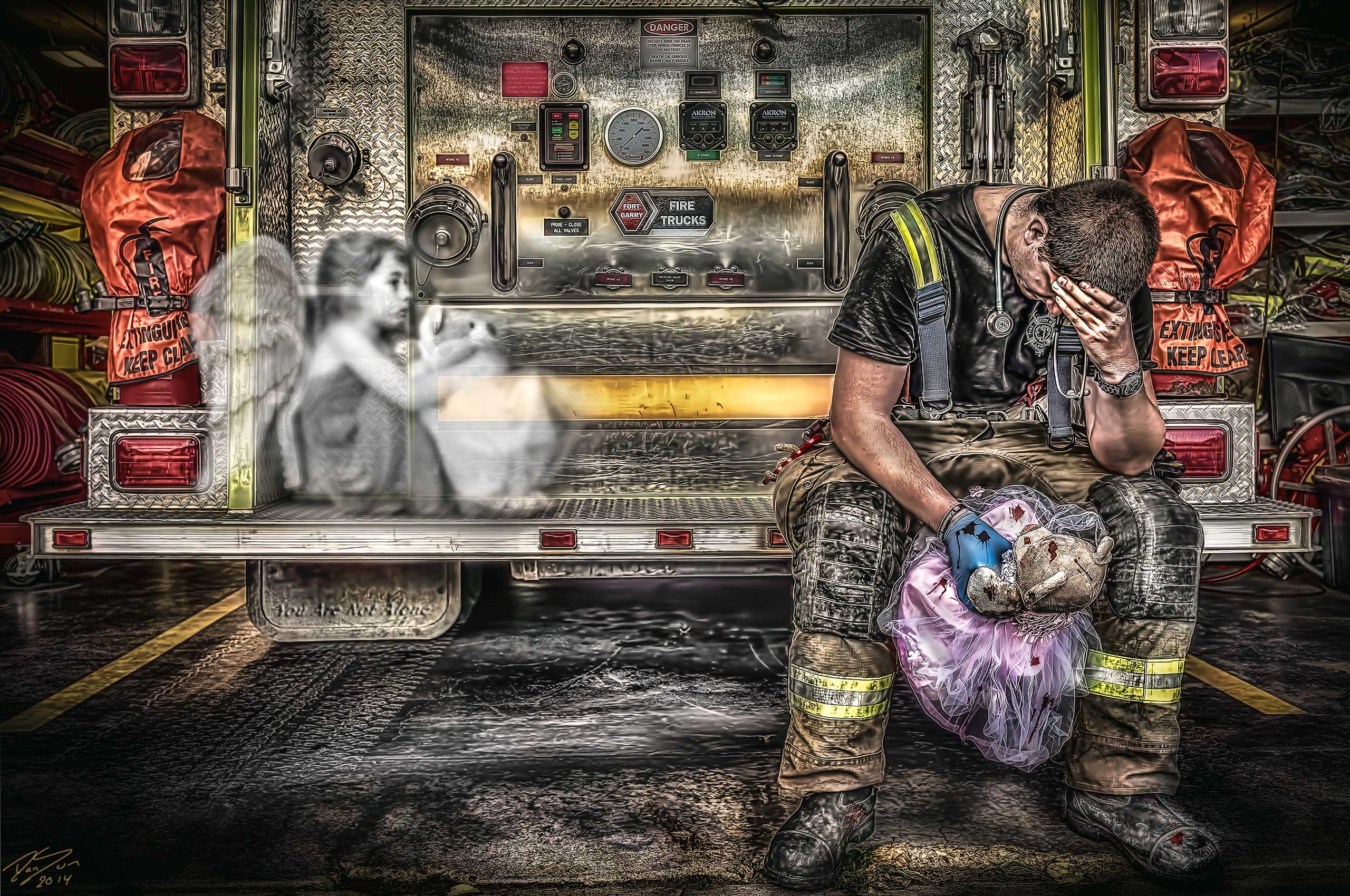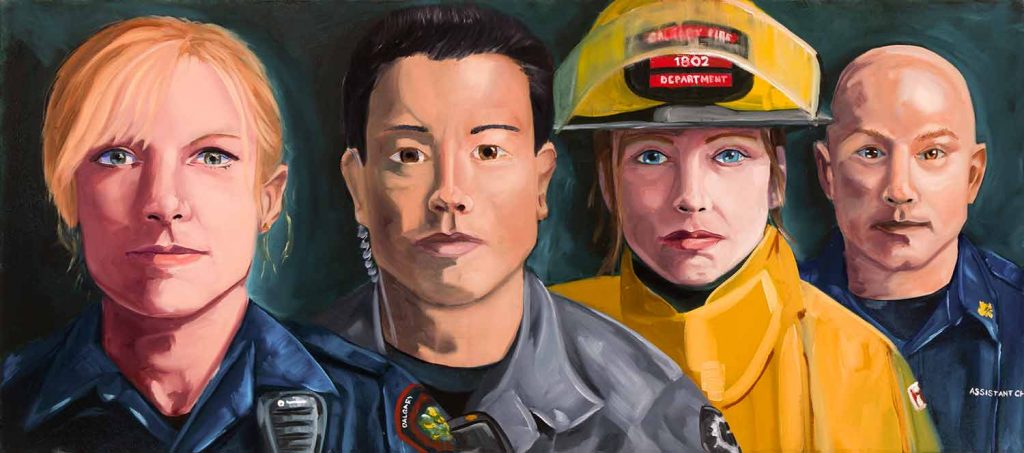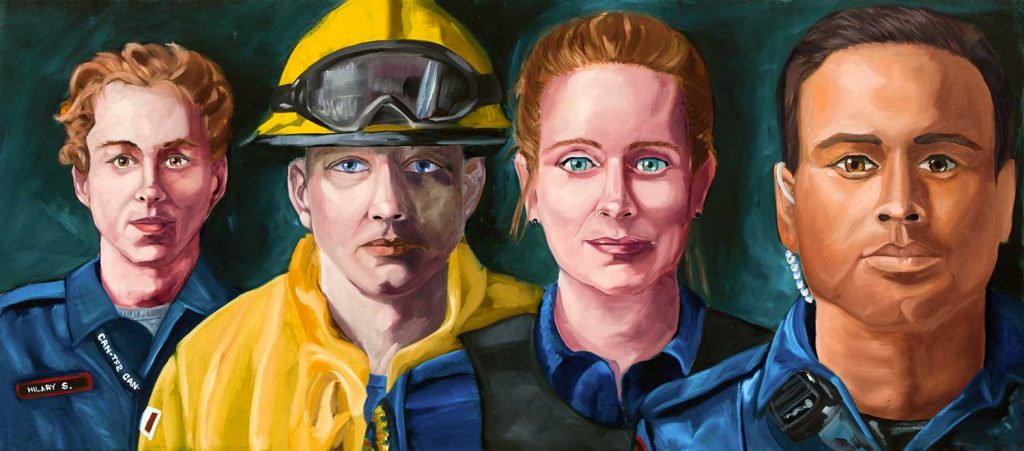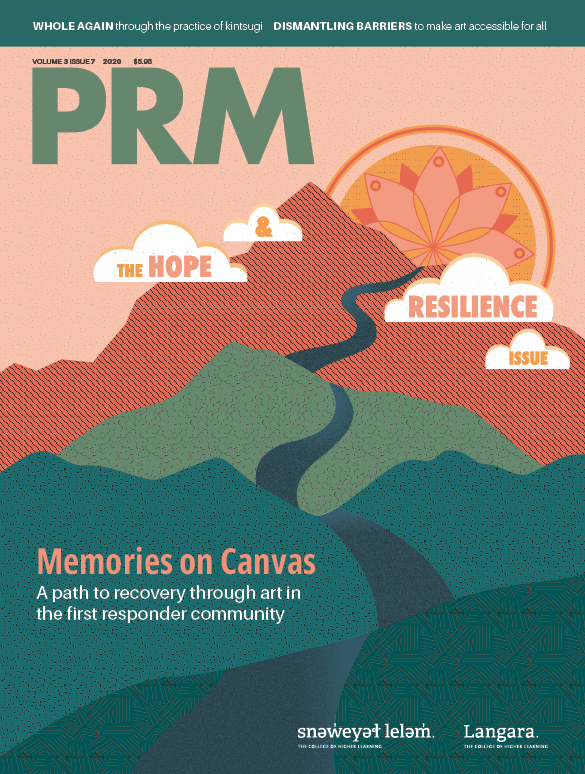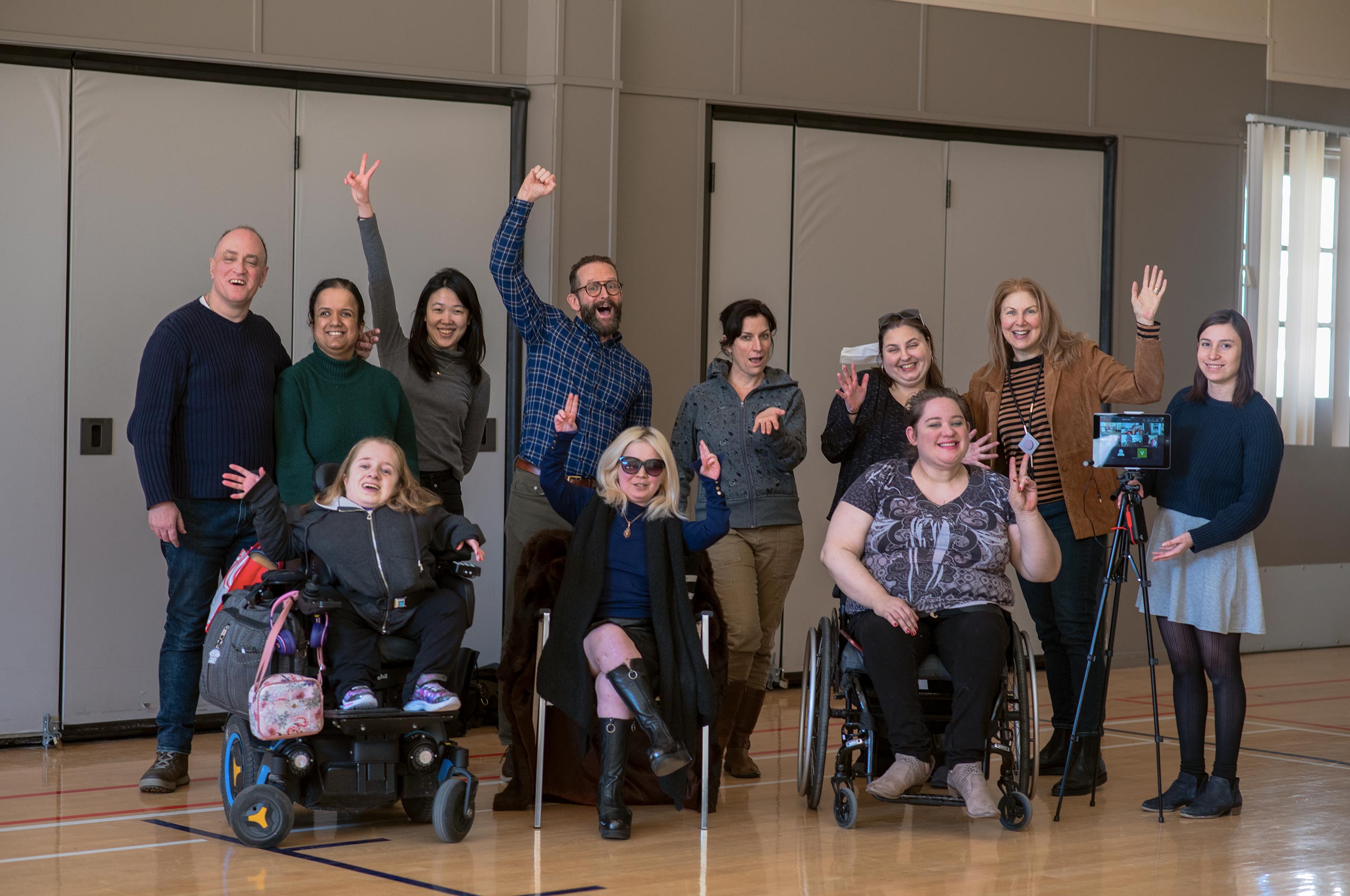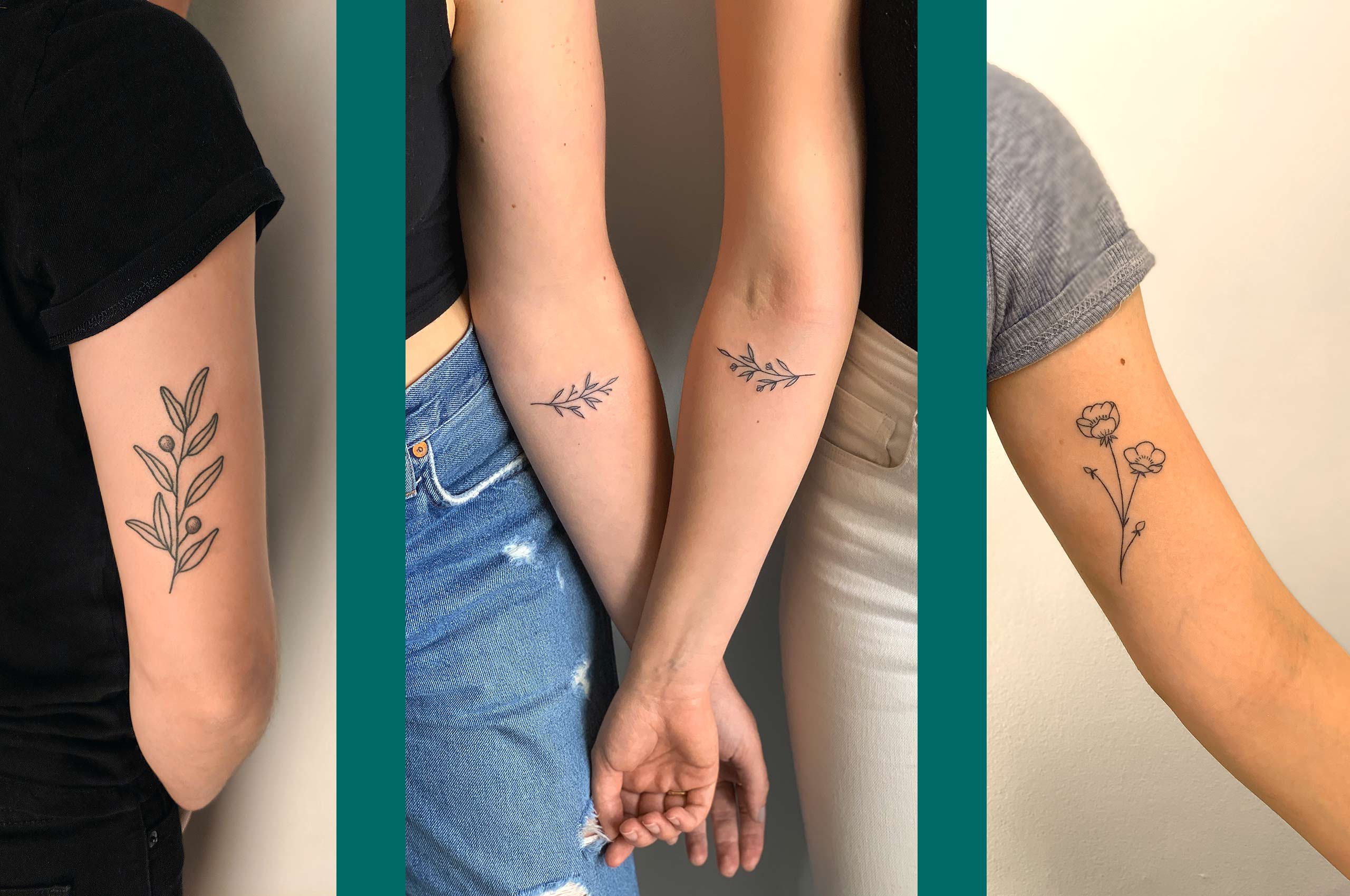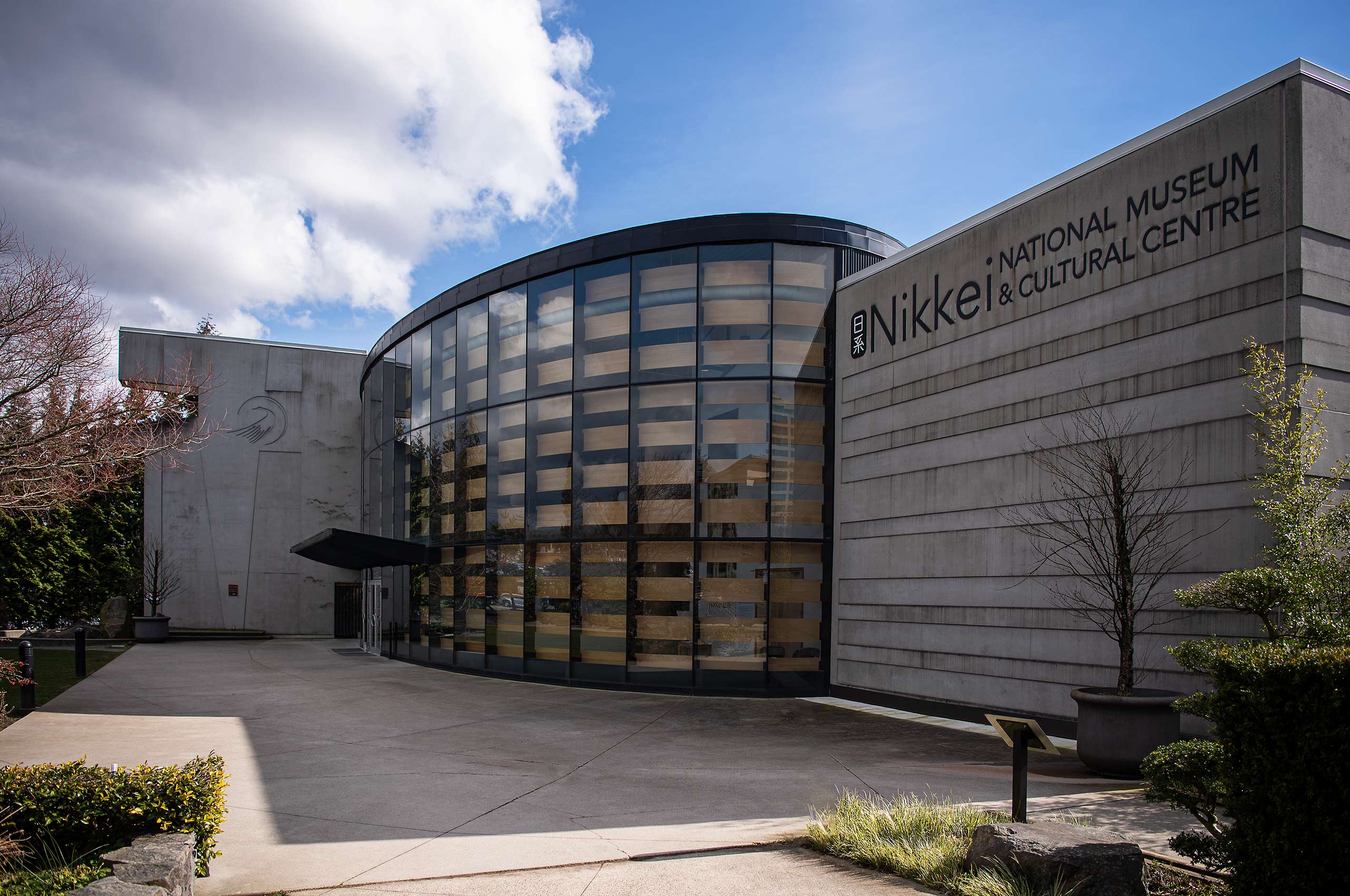The little girl is found in her car seat, her teddy bear no longer safe in her arms. An irreversible silence enshrouds her, separating her from the sirens and the flashing red and blue lights. She will never be able to tell the first responder the name of the bear he found in the ditch.
This is just one reality of the calls first responders may attend to. As heroes and helpers, they routinely face stress, trauma, and life and death situations. While not all first responders will develop an occupational stress injury, a study published in 2018 by the Canadian Journal of Psychiatry, “Mental Disorder Symptoms among Public Safety Personnel in Canada,” indicates traumatic events elevate mental injury risk, including post-traumatic stress injury (PTSI), which is clinically known as post-traumatic stress disorder (PTSD). Julia Hyslop, a registered clinical counsellor and trained occupationally aware clinician in Vancouver, says, “the stressors are diverse, and I think that’s important. Like PTSI and trauma, there’s diversity there. In what it looks like but also how it happens and why it happens.”
Statistically, because of their line of work, first responders are at a greater risk of sustaining mental health injuries. Hyslop explains that the longer responders serve and the more calls they attend, the greater that risk becomes: “Mental health issues are positively correlated with call volume.” In this regard, the British Columbia Professional Fire Fighters’ Association (BCPFFA) reported on their website in 2019 that a 2017 Canadian survey of 6,000 first responders found 44.5 percent were affected by mental health injuries or disorders, while the average for the general public is 10 percent.
For a long time, the memory of the little girl haunted Daniel Sundahl, the Alberta paramedic and firefighter who found the teddy bear at the collision site. It was only when he began recreating the image with photo art (photography and digital painting) that he was able to work through the memory and emotions. By depicting the girl sitting on a fire truck bumper, with angelic wings and holding her bear once more, Sundahl could remember her differently from the accident scene: “I was able to almost change my memory of that. The first image I have of her now is that image I created of her on the back of the bumper.”
Approximately five years ago, Sundahl embraced art as a way to work through trauma and complex emotions after his therapist suggested he apply his painting hobby to process his memories. His first paintings were based on a call to a scene that stayed with him for over ten years: a 22-year-old motorcyclist hit by a drunk driver. He vividly recalls the dying man calling out, “mommy, mommy!” What impacted Sundahl deeply was that the mother would never hear these final words.
Sundahl portrayed the complex emotion of this call in two paintings. In Trauma Code 2, the man’s spirit watches a paramedic who sits holding his bowed head with gloved hands. He explains that “the spirit is basically telling the paramedic that you failed his mom.”
Sundahl did not share the completed image for a long time. He was concerned about what others would think, especially having depicted the paramedic touching his head with gloved hands: this is not an approved practice in paramedic culture and operation, since it is in conflict with hygiene protocols. Additionally, at the time there was greater stigma surrounding first responders’ mental health than there is today.
Melanie Stephens, a paramedic and the mental health and wellness coordinator for Ambulance Paramedics of British Columbia (APBC), explains, “the culture of first responder organizations in the past has been an attitude of ‘This is what you signed up to do, so no matter what you see or do, you need to suck it up and find a way to deal with it.’ ” Hyslop adds that the idea of counselling can go against the identity of a first responder as a protector and dependable peer and can stir up perceptions of weakness, shame, and guilt.
However, when Sundahl posted the painting of the paramedic and the motorcyclist on Facebook, the response was unimaginable. In one day, his followers went from 30 to 30,000. “I thought my phone was broken,” he says. Many comments left on the post were from other first responders telling Sundahl what the painting meant to them: “It went viral right away, and people really connected.” He says that everything changed that day.
From Memory to Concept
Cassandra Evans, a registered clinical counsellor and BC art therapist, explains that art can act as a practice of de-stressing and regulating emotion (inherently therapeutic) or as an exploratory medium (in therapy). In either application, art is successful in helping individuals process trauma or mental injury, as it bypasses language and communication barriers allowing access to, and expression of, trauma, which is often stored as mental images. In addition, moving an emotion or thought out of the body into a physical space can also make it easier to understand.
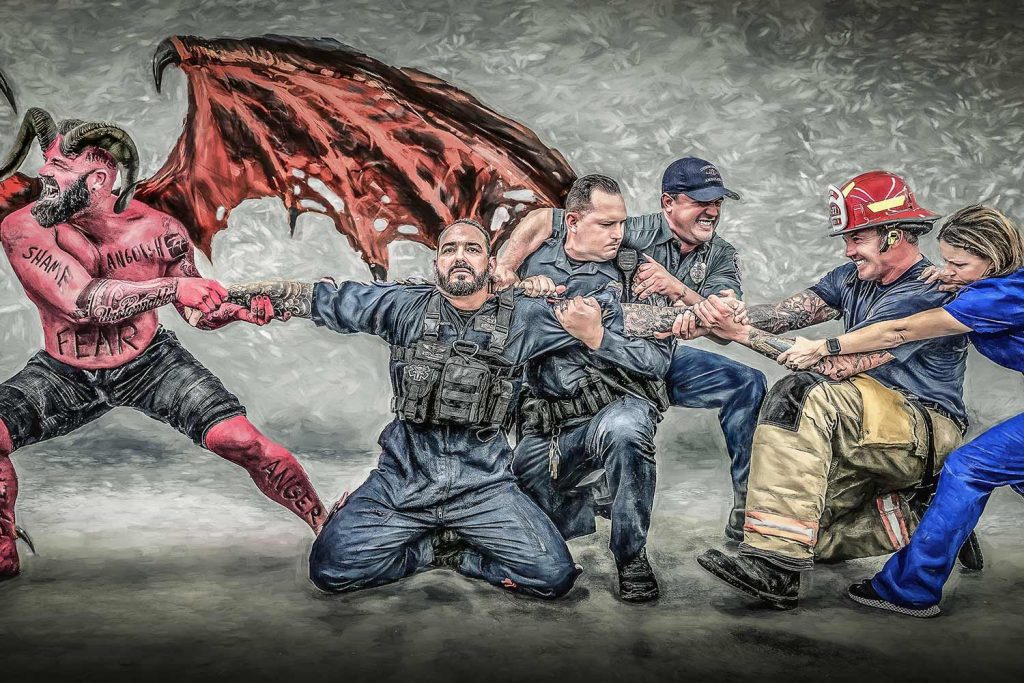
In Sundahl’s case, art has acted “as a way to purge these calls from my memory.” When creating his concept paintings, he searches for an image to convey the complexity of a recurring idea, emotion, or memory in an understandable way. He stages and photographs the base image and digitally paints overtop, adding elements like spirits, angels (representative of recovery), and demons (representative of trauma).
The painting that most authentically portrays concept and process—and Sundahl’s favourite—is Demon Eats the Ambulance Driver. This powerful piece depicts a demon devouring a paramedic. It expresses the point of giving up, laying down defences, and ultimately giving in to suicide. Sundahl clarifies that while “ambulance driver” is a derogatory term in paramedic culture, he intentionally used it to communicate that “he’s no longer a paramedic: he’s simply an ambulance driver at that point, ‘cause he’s just given in.”
Death by suicide is devastating in the first responder community. Erica Koopmans’s article, “Emergency Response Services Suicide: A Crisis in Canada?” published in 2017 in the Journal of Loss and Trauma, reviews statistics that report there were 51 deaths by suicide in 2015, and 48 in 2016.
Suicide has been one of the forces mobilizing first responder communities to raise awareness for mental health and breaking the stigma. Stephens says that over the past five to six years, there has been significant improvement. In 2015, Worksafe BC created the BC First Responders’ Mental Health Committee and launched the Share It. Don’t Wear It campaign.
In addition, the BC Professional Fire Fighters’ Association started a task force in May 2015 to address the mental health of Canadian first responders. In October 2017, the task force introduced training for counsellors in BC. The goal was to create a website directory of occupationally aware clinicians specifically for responders, which launched on November 12, 2019, and contains over 150 professionals in BC. The training has gained interest in other provinces and has extended into Alberta and Saskatchewan. Hyslop, who completed the training, says one of its main focuses “is about the unique culture and experiences of first responders that are needing to be understood in order to build bridges with the first responder community… They don’t need to teach us about their culture, we already know it. And that’s really important for them to get through the door to get help.”
Sundahl wants people to know that post-traumatic growth and recovery are possible and has been a passionate advocate for first responders’ mental health. He is the founder and president of the Peer Recovery and Resiliency Society, which was established in 2018 and holds yearly conferences. In addition to his concept art, he promotes the first responder profession through group and individual portraits. Ultimately, his journey led him to a deeper connection with first responders in Canada and worldwide. He recalls a profound moment from a recent speaking session: “This one woman came up and she had tears in her eyes. And she just gave me a hug and said, ‘You just saved my life.’ That’s all she said.”
Regardless of the medium, art enables individuals to process emotions and memories differently than any language. As Hyslop puts it, “art offers, really beautifully, a non-verbal language with which to communicate and process trauma where words fail.”
Not the End of the Story
Teresa Coulter, a primary care paramedic in Calgary, AB, found that art not only builds resiliency, but also allows her to form deeper connections with other first responders. In the year-long project Sock Drawer Stories, each month she painted a portrait of a paramedic dealing with PTSD. Originally Coulter intended the project as a way to understand this injury: at the time, there was less awareness about mental health, and the community was hearing of peers dying by suicide.
While some of the paramedics who sat for Coulter told their stories and others did not, the space that she provided in the painting sessions allowed each to be seen and understood as they were. After the project’s completion, Coulter felt more connected to these paramedics, and saw her art reaching further than she imagined. The 12 portraits were showcased at the University of Calgary in June 2015 and gained national attention. “It was this non-invasive way of talking about mental health without actually talking about mental health,” says Coulter. Now five years later, she is still encouraged by the letter one participant sent her: “He said that finally he felt like somebody had reached inside of him, and he knew he wasn’t alone anymore.”
Following Sock Drawer Stories, Coulter has sat on advisory boards, spoken at conferences, and connected with over 300 first responders. In 2018, she painted eight portraits of first responders for a project called Operation C Formation for a suicide awareness conference held by the Calgary Police Department and the Legacy Police Society. Today she remains passionate about first responders’ mental health and finds that art works as a bridge to open up conversations and create connections. “Art has this way of shaking up still water and allowing things to emerge,” she says.
Art also has a way of calming turbulent water and strengthening communities. In 2017, the Ashcroft and Cache Creek communities endured a succession of tragic events. Sergeant Kathleen Fitzgerald of the Royal Canadian Mounted Police (RCMP) recalls the death of a family from carbon monoxide poisoning, a flood that claimed the life of their fire chief, the Elephant Hill wildfire, and fatal car crashes: “There was a lot of trauma that occurred, and that was very close to everybody.”
In the wake of the 2017 events, an anonymous member of the RCMP detachment suggested creating an art mosaic to promote healing, bring the community closer together, and honour first responders. Unveiled on September 22, 2019, and titled Stronger Together, the mosaic depicts members from each responder service (firefighter, RCMP, paramedic, and emergency support) linked together arm-in-arm. It represents the unity and strength of the first responder community.
The mosaic is powerful not only in its imagery, but also in how it provided space for conversation, healing, and bonding. First responders were welcomed and encouraged to participate in its creation. Throughout the process, Fitzgerald witnessed how the physical act of making, learning new skills, and evaluating each artistic choice contributed to opening up conversations and connections. “The creative process was really quite something to be a part of and to watch, and to hear people come up with their ideas and why it was important for them,” she says.
While art aided in healing and building bridges, Fitzgerald points out that the mosaic was not the only road to healing. “It’s not like we took it on ourselves to heal everybody through art,” Fitzgerald explains. “If there was someone who was struggling, that needed professional care, that was offered, and avenues were made easy for that person to reach out.” She also believes that the mosaic would never have been created without a growing awareness and decreasing stigma around first responders’ mental health.
“We’re just not alone,” Fitzgerald reflects. “We just have to open our mouths and hearts to know that. And sometimes that’s the hardest thing to do. Especially when you’re used to being the one running into it, not running away.”
If you or someone you know is wrestling with a mental health injury or suicidal ideation, you are not alone: help and support are available. As Coulter assures you, “being injured is not the end of your story.”
For help or support, contact
Crisis Services Canada: 1-833-456-4566
BC Mental Health Support Line: 310-6789
BC Suicide Help Line: 1-800-784-2433
or your closest health centre.





